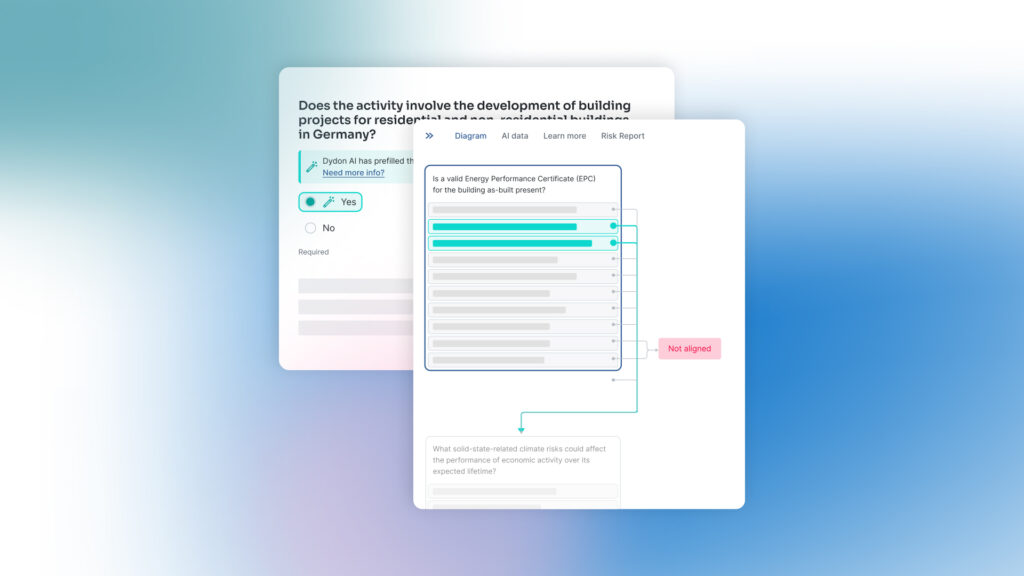In the last decade, European institutions have put significant effort into making finance and investments more sustainable. The EU’s recently introduced Taxonomy Regulation aims to facilitate the transition of the economy under the European Green Deal with a strategy to increase transparency and reorient private investments towards projects that are sustainable for the planet and the people inhabiting it.
In this article, we will examine how the EU Taxonomy is impacting banking and banks’ lending practices.
Where will the EU Taxonomy find its application in the banking industry?
As we saw last month, European banks are now required to report ratios related to their taxonomy-eligible exposure and to entities not subject to the Non-Financial Reporting Directive (NFRD), as per Article 8 of the Sustainable Finance Taxonomy Regulation.
These new obligations mark the initial stage of new reporting responsibilities, with more comprehensive requirements to be implemented next year through the Green Asset Ratio (GAR) – a newly introduced key performance indicator (KPI) designed to offer a standardized and comparable measure of the proportion of a bank’s assets invested in environmentally sustainable projects and activities.
Nonetheless, while the Non-Financial Reporting Directive (NFRD) only applies to large EU companies with over 500 employees that are of public interest, the impending Corporate Sustainability Reporting Directive (CSRD) will significantly expand the spectrum of application.
In fact, the CSRD will also be applied to smaller listed companies and all large companies that meet at least two out of three criteria (250 employees, €40 million in revenue, €20 million in total assets), as well as non-EU companies with significant activity in the EU market, thereby increasing coverage from 11,000 to around 50,000 companies.
The CSRD will require as well companies to disclose more sustainability-related information than before, and with the additional obligation that these data will need to be digitally tagged and externally verified. The provided information will be evaluated based on the definitions and standards set by the EU Taxonomy, and the concept of double-materiality will be used to assess the impact of sustainability issues on both the companies and the environment.
The application of the CSRD will take place in three different stages, with the initial one starting on 1 January 2024 (reporting in 2025 on the financial year of 2024), affecting companies already subject to the non-financial reporting directive (NFRD).
As we’ll see below, the EU Taxonomy will affect the reporting, but it will also affect the lending process and bank customers.
The effects of the EU Taxonomy on the lending process to banks’ clients
With 99% of firms in Europe being SMEs that rely on financial institutions for 70% of their external funding, banks play a crucial role in financing these firms. As such, it is necessary to comprehend how these new regulatory measures may impact banks’ lending practices.
In this sense, Dydon AI’s CEO and founder, Dr. Hans-Peter Guellich, explained it in clear words in a recent interview with FinanzBusiness.de. “If a credit institution wants to proceed according to the EU taxonomy, it has to check each loan since the beginning of 2023 whether the financed project or the associated economic activity is also green according to the EU taxonomy. This applies not only to corporate clients but also to real estate purchases by private individuals, for example.”, said Guellich.
“In the past, the creditworthiness of the debtor was checked, the property was considered from the point of view of its residual value and the risk was assessed in this way. Now the consideration of the object is expanded to include whether it is ‘green’ in the sense of the taxonomy.”, he added.
What is the actual situation of green loans and mortgages?
The housing sector plays a paramount part in achieving the transition towards sustainability, as the environmental impact of buildings encompasses a large and wide range of factors. To address the significant energy consumption and CO2 emissions associated with buildings, current EU policies focus on the energy performance of these structures during their use phase. Buildings account for 40% of the EU’s final energy consumption and 36% of its CO2 emissions, making them the largest source of energy consumption in Europe.
Though, for a better understanding of the current state of green mortgages, we first need to clearly determine how the EU Taxonomy regulation and SFDR define sustainable assets and activities.
In that regard, the European Banking Authority (EBA) comes to our help with this report, where it’s highlighted that mortgage loans, which constitute the main component of the assets of EU banks (approx. 30%), are considered green only when the underlying property has a class “A” energy performance certificate (EPC), or it’s positioned in the top 15% of the most energy-efficient properties. Still, the rate of class “A” properties is pretty low across Europe, with green buildings that are around 15% of the total.

Other examples outside the Real Estate sector
Looking into auto asset-backed securities (ABS) – basically loans and leases for low-emission vehicles – electric vehicles are automatically classified as green under the Taxonomy, while plug-in hybrids can also be eligible but only during a transitional period until the end of 2025.
Nonetheless, the number of electric vehicles and plug-in hybrids in circulation currently remains extremely low, accounting for just 1.2% of the EU’s total passenger car stock. Therefore, despite the anticipated rapid growth, it will likely take significant time for fully green auto asset-backed securities to occur.
In general, banking assets that comply with the EU taxonomy standards constitute a small portion of total banking assets. In fact, according to the EBA’s calculations, EU credit institutions’ average green asset ratio is presently just 7.9%.
Solutions for banks to check the compliance of loans with the EU Taxonomy
The EU Taxonomy regulation is a significant step towards a sustainable economy, and the financial sector is called upon to play a crucial role in achieving such a key transition. While applying these regulations poses significant challenges to banks.
If your bank needs a solution to handle all the new EU Taxonomy obligations, Dydon AI has an AI-powered software solution called TAXO TOOL that has been developed with just that specific goal in mind.
If interested to learn more, get in touch with us for a free demo of our AI solution
Article in other languages
Sources:
EBA Report – DEVELOPING A FRAMEWORK FOR SUSTAINABLE SECURITISATION EBA/REP/2022/06
Call for advice to the European Banking Authority on green loans and mortgages






